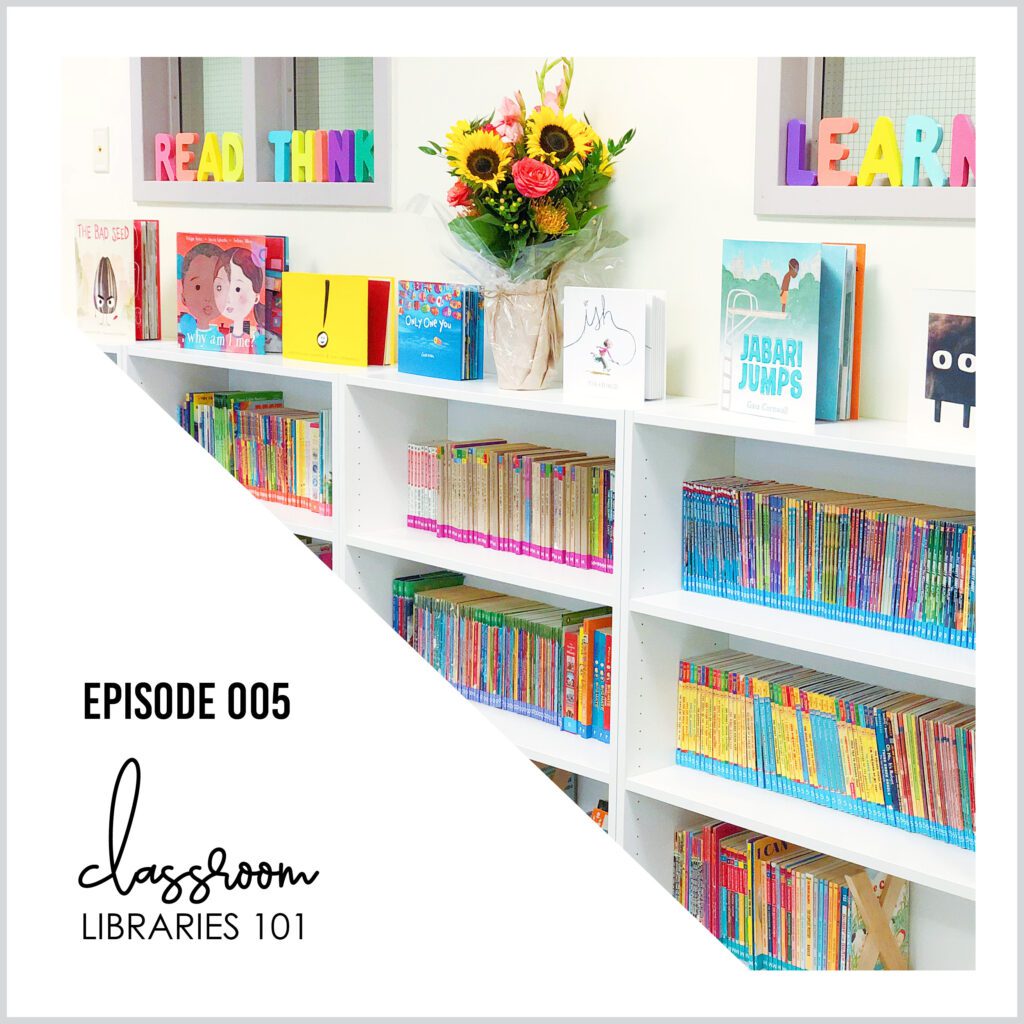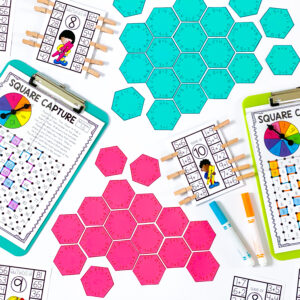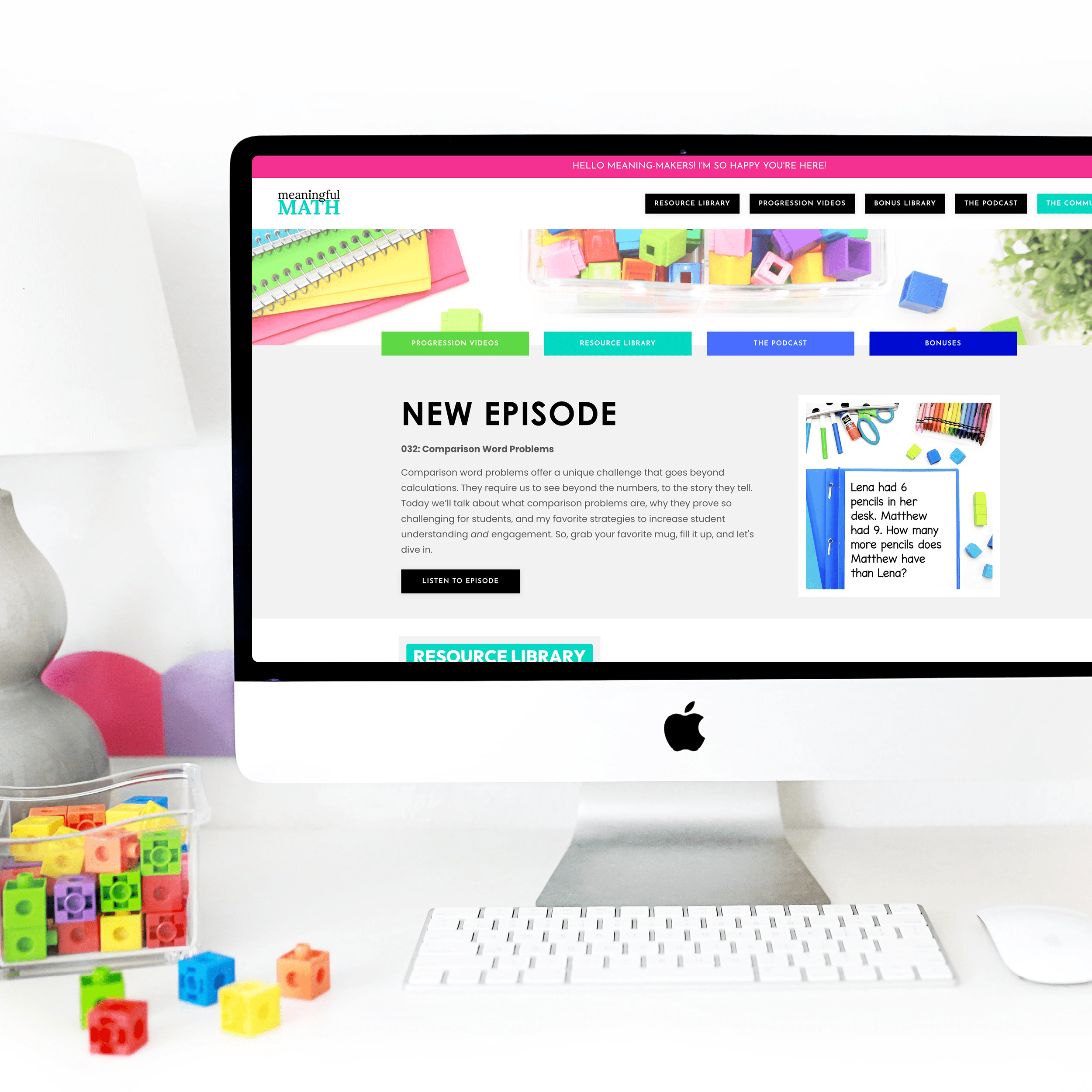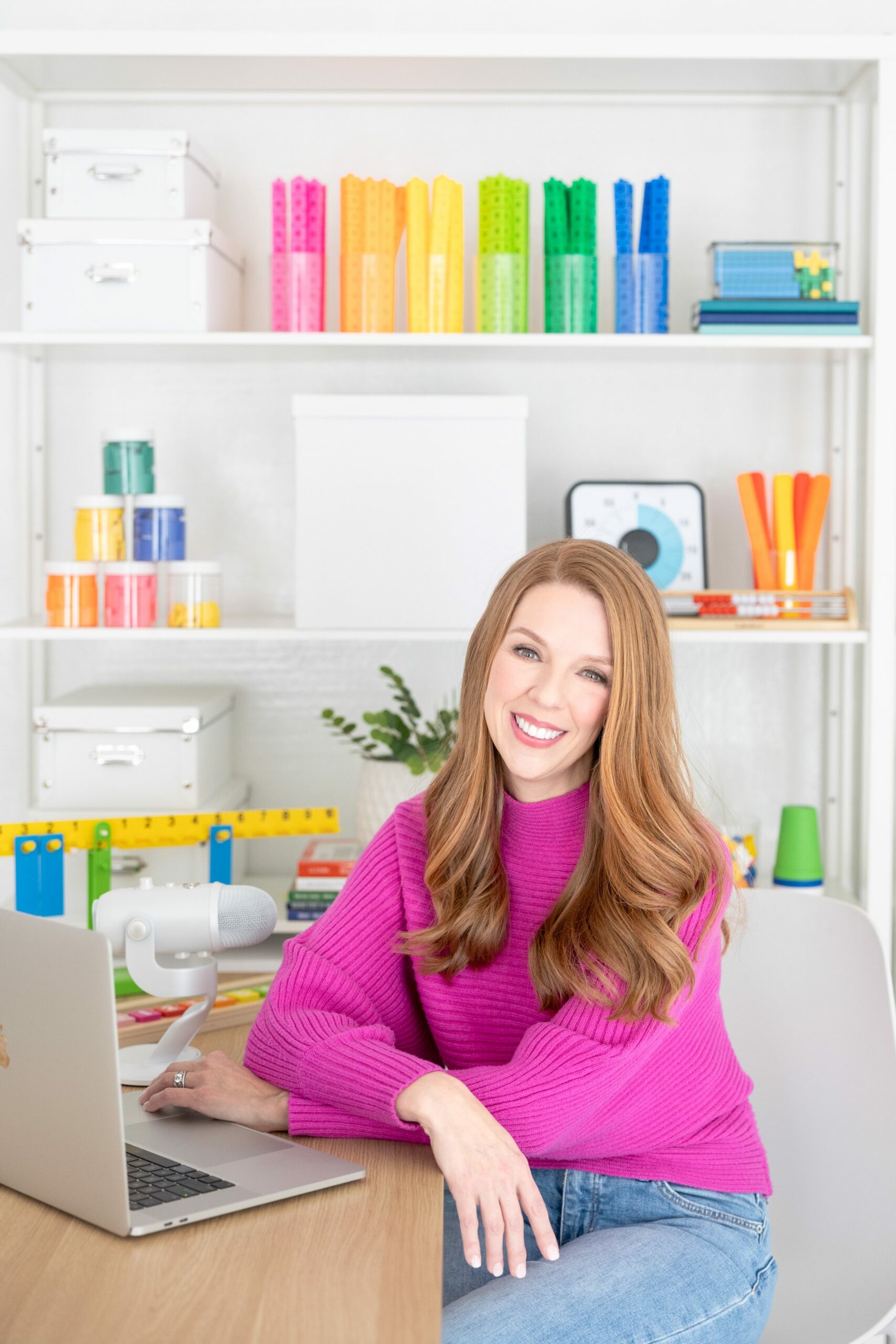
Episode Transcript
How should I organize my classroom library? It’s a question I am often asked, so let’s talk about it. We will dive into all of the following topics:
- bins vs. no bins
- leveling vs. non-leveling texts
- the do’s and don’t of organization
- how to fund your classroom library
- how to use your library space to engage your readers!
The disclaimer I put out there before we proceed, it to let teachers know that there is no ONE right way to organize your classroom library. I have actually reorganized mine several times because I’m always growing and learning new things, but I also like to tweak my library every year to meet the needs of my unique group of students.
I want to make it REALLY clear that there is no one-size-fits all for library organization. My goal is to give you some ideas to think about, and some practical tips for funding and organizing your library so you can maximize your space.
LIBRARY ORGANIZATION
Location
Where you choose to house your classroom library speaks to the emphasis we put on literacy in our classrooms. For a long time, I put my my library in the back corner of my room, because I wanted it to be a nice, quite space for my students. It wasn’t doing any HARM back there, but what I realized over time was that by placing it in the back corner, I was subtly removing it from the rest of my room. I know it might sound silly, but I’m only speaking from experience with making the shift myself and seeing the difference it has made in my classroom space.
When I chose to put my classroom library at the center of my classroom, so that when you walk into my room, the library is RIGHT THERE. It is the very first thing my students see when they walk in. They see all of the books out on display. They see all of the spines. They are immediately met with books. Books are there every time they need to go to the bathroom. Books are there when they have to go get their work. They are constantly having books pushed in their face; covers of beautiful books that might attract them and say, “Hey! Read me next!” They’re always there, front and center, to get my students excited about reading.
It does sound like a very small change, but from my experience, the level of interest in my library space increased dramatically JUST by moving its location to a place in my classroom that got more foot traffic.
From Bins to Spines Out
After I shifted the location of my library space, and I saw the effect that it had on my students, I started to think about other parts of the library itself, and how I could continue to increase engagement with the space by making little changes. I want to share a few of those changes that I’ve made over the years, and why I think they’re working.
The first change I made is hard to bring up, because I know it polarizes groups of teachers, and that’s TOTALLY OKAY! You don’t have to agree with me on this one, but I just want to share my experience and how it has shifted the engagement level in my classroom. (Don’t hate me!)
I used to have bins for all of the different series and genres in my classroom library. I had these cute labels, and I beautiful neon bins and they were GORGEOUS! I loved the look of my space. After a while I started to wonder if I was keeping these bins because I liked the way they looked in my space and how they brighten my room, or because of their functionality?
Now, the idea of getting rid of these bins made me want to break out in hives. So many of you know the struggle! I had spent weeks of my summers trying to head to different Targets, Ocean State Job Lots, and Walmarts to find these matching bins that would all fit perfectly on my shelves and be color-coordinated, because my head explodes when one bin is a different shade of blue than the one next to it. I wish I didn’t have this problem, but I do.
Additionally, all of my books had labels that matched the labels on the bins. I had laminated all of the bin labels, and I had so much time and effort invested in this. I share because I need you to know how hard it was for me to even contemplate changing things up. But at the end of the day, I needed to ask myself why? Why did I choose THIS method over something else, and was it because I liked the way it looked, or because it was what would be best for my kids?
I truly couldn’t answer it, so I took the plunge and I said “I am going to try something different. It might completely fail, but I need to try it so that I know that what I’m choosing is not for ME, but it is for my STUDENTS. I also want to make it really clear that I made these changes to find out what was right for my students.
So, as much as it broke my heart, I took out all of the neon bins. I decided that I wanted my students to access our library in a way that would help them better navigate our school library, town libraries, and book stores. I had noticed that my students struggled to identify authors and how to browse for books in a more traditional library system. I thought that by putting my books in a display that mirrored other experiences that they would have with navigating books, that I could be supporting them with their future browsing needs.
Pretty With a Purpose
Now, I didn’t quite know I wanted to do this, because I needed something that would still fit my need for our space to be visually appealing (It’s just something I need- Don’t judge!) However, what can’t happen is that my need for pretty interferes with what’s best for my students.
How did I marry the two needs for pretty AND purposeful and functional organization? Well, thankfully there are some brilliant teachers out there, and I found one who solved all of my problems. Her name is Molly Malloy from Lessons with Laughter. She has an editable resource on Teachers Pay Teachers resource which is simply Avery labels being used as binder spine labels.
I have chosen to organize my fiction books by author last name, because that is most likely what my students will experience in other libraries. Using Molly’s resource, all of my fiction books written by authors with a last name beginning with A, will have a matching Green label with the letter “A” in the center that will show up on the binder spine.
Some Major Teacher Wins:
- A lot of my students read books, but they don’t always realize who the author is. Not having this important detail means that they cannot then go to another library or bookstore and seek out that same book series to continue their reading. I love that this organization method forces my students to pay attention to who is writing the books they’re reading.
- My students can see EVERY SINGLE BOOK in my library with the spines out.
- It doesn’t overwhelm my students because there is also the color coordinated aspect of this method. When my students look at the five bookcases of chapter books in our classroom (we will talk about funding later!) they are not JUST looking for the letter “L”. They are also able to visually search for the color to match.
- They are much better at putting books away in the right place INDEPENDENTLY, which means I spend less time cleaning up!
- My chapter books are lasting longer with the spine out method than they did in the bins. They aren’t bending in the bins, and are instead held straight up, being compressed on either side by the other books on the shelf.
What Do I Do with the Picture Books?
Originally, I thought that I was only going to go FULL spine out for my chapter books. I used the same labels on my picture books, and I still organized them by author last name, BUT I kept them in bins, as you can see below.
While I liked the look of this, it made it hard for my students to browse our picture book section, and found book jackets tearing as they made their way in and out of bins. I decided to try it without bins, and WOW! It made such a huge and unexpected difference. Now, my picture books are clearly visible for browsing, AND my students fingers can graze along the spines, easily pulling out any that might catch their eye.
ADDED BONUSES: They take up far less space without bins, so I removed an entire bookshelf (which meant more options for seating!) Also, students truly BROWSE now, and they stumble upon so many more books in our library because they aren’t just going to their favorite bin. They are actively searching through ALL of the books because they are all together. They are now stumbling upon narratives, characters, and genres that they might not have seen before.
Non-Fiction Section
One part of my classroom library where I still use bins in our non-fiction section. I don’t know about you, but the majority of my informational texts are paperback, and rather fragile. I keep these books together by topic, again mimicking a regular library model with the Dewey Decimal System. Those bins are individually labeled with the books inside having a matching label.
I also have another non-fiction section of my library, which we call Leaders For Change. It is filled with all of my favorite picture book biographies. I have a deep, deep love of highlighting people throughout history who have really made a change. I work hard to make sure there are a variety of narratives in this section, and that I am including voices that are often left out of our history text books, and have gone far too long without representation in our classroom libraries.
This section is important because these are books that my students NEED to be reading. Whether or not I am teaching to a group of students that are all white, or I am teaching a group of students that represent the global majority, I need to provide these examples for them so they hear ALL voices. This goes for all fiction texts as well.
Windows, Mirrors and Sliding Glass Doors
Dr. Rudine Sims Bishop said “Books are sometimes windows, offering views of worlds that may be real or imagined, familiar or strange. These windows are also sliding glass doors, and readers have only to walk through in imagination to become part of whatever world has been created or recreated by the author. When lighting conditions are just right, however, a window can also be a mirror. Literature transforms human experiences and reflects it back to us, and in that reflection we can se our own lives and experiences as part of the larger human experiences.”
It is important that as we are adding a variety of voices to our classroom libraries, we ensure that we place these books with all of the other books in our library. There was a great conversation a while back on Instagram about the idea of having a “Multicultural Bin” or “Diverse Books Bin”. It was pointed out that this practice is very damaging for our students because what we’re REALLY doing is saying, “Here is the white norm of the books in our class library, and here are the OTHER narratives.” The idea of keeping these books separate and what that says to our students is something that we need to take seriously.
Organizing Mentor Texts and Themed Sets
I often get asked how I organize my mentor texts, themed sets, or books I use to foster specific conversations in my classroom? Nearly all of the books in my classroom are housed in my classroom library. The only books that I keep separate are when I have multiples of the same texts that I would use for guided reading groups, or they are very content specific (books provided by my district to support curriculum).
The Best Library App Around
I almost always get asked the follow-up question: Then how do you keep track of all of them? Well, this girl has some really smart friends. Dia, from Elementary Edventure introduced me to an amazing app called The Book Buddy.
With this app, you can scan in every book in your library using the bar code on the back. As you scan each book, you can tag them. Each book can be tagged multiple times. For example, I might tag one book as “January” for my winter display, but also might tag it as a mentor text for a specific reading skill, as well as under the theme of friendship.
Once all of my books are in the system and tagged, the possibilities are endless. I can tap on the tag “January Books” and be provided with a list of all of my text that fall into that category. Then I can just pull them all out of my library and put them on our display shelf. When I’m done displaying them, I can put them all back, and my students will still have access to them for the rest of the school year.
This app has also been really helpful for keeping track of the books in my library. When I’m in meetings or planning with colleagues, my list of books is right at my fingertips. There is no more, “Oh, I’ll run downstairs and see if I have it,” or “I’ll check when I get to school tomorrow.” It has also saved me from trips to the public library, or ordering duplicate copies!
Why I Refuse to Level My Library
One part of library organization where I have VERY strong feelings about what is best for our students is around leveled libraries.
As a child, I loved books. If you’ve read about my journey from struggling student to passionate educator, you read about reading time in my home being a favorite part of the day. There are early albums filled with photos of little Jillian asleep on a pile of books.
Then I got to school, and as an undiagnosed dyslexic student, reading in school was really a struggle. Unfortunately, the struggles were further compounded by my reading environment. I so vividly remember being in the Green Turtle reading group. (That name alone is a whole different story!) My group was only allowed to pick from certain bins in our classroom library. Most of my non-English speaking friends were in this group with me.
Over the course of the school year, my friends slowly moved into different groups and began picking from different bins, but I stayed. Even as a seven-year-old, I knew what this meant about me as a reader. It was at that time that a lot of the photos of me with books stopped showing up in our family photo albums.
So as we start considering how to set up our classroom libraries, and we start thinking about how our students will access books, I really want us to think about what we are saying to students when we put limitations on them, and tell them what they can and cannot read. Nobody ever fell in love with a book by checking its level!
Funding a Classroom Library
I want to get into how to fund your classroom library. I often get asked where the books in my library come from. Did my district provide them? Do you have donations? The simple truth is that the majority of them came from me.
We know that teachers don’t get paid a lot, so I’m not advocating that teachers should be paying out of pocket to build their classroom libraries. In an ideal world, our tax dollars would be paying for them. They would be a part of our education budget, and every school would allocate funds to provide each classroom with a robust and diverse library for to our students.
Unfortunately for most teachers, that is not the case right now, so in the mean time, what can we be doing to make the most of what we have, without breaking the bank?
Here are some great ways I have purchased books with a budget:
- Scholastic Book Points: Their dollar books and discounted series are gold!
- Ebay: Often parents will sell entire lots of books when their children outgrow them. When you score, you score BIG!
- Facebook Marketplace: So many people (parents and retiring teachers) are listing their personal libraries on FB Marketplace. Keep your eyes open!
- Local Library Book Sales: Most libraries do annual (or even semi-annual) house cleaning. I love going to purchase the books that they are removing from circulation because I score some great books, and the funds go to support my local library at the same time!
- Used Book Stores: A lot of used book stores, and used book sections of your neighborhood bookstore are gems!
- Yard Sales: I can’t tell you how many amazing finds have come from randomly browsing a neighborhood yard sale!
- Grants: Whether this is done at a district level, a school level with your PTO/PTA, or on platforms like DonorsChoose.org, writing a grant to help fund your library can make a big impact.
- Wish Lists: I create Amazon Wishlists at the beginning of every school year to share with parents, friends, and family. I also allow my students to add to this wishlist throughout the year. It’s a great way to engage them in our classroom library, by providing books that THEY are recommending to their peers.
And there we have it! Those are my best tips for organizing and building your classroom library. I hope you have some great takeaways that you can utilize to make your library a welcoming space that your students love and look forward to entering. I hope you will be organizing with the intention that multiple narratives and voices will make their way into your students hands and encourage a love of reading by providing unlimited choice in your offerings.




Leave a Comment